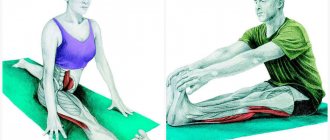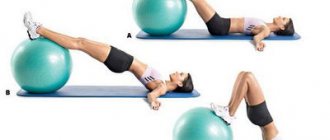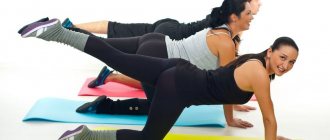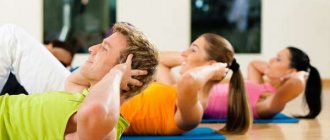The frog exercise allows you to comprehensively work out the lower body, strengthening the muscles and improving flexibility. Due to its comprehensive effect and high safety, it is used to train preschool children. Consistent practice not only provides health benefits, but also reduces the risk of injury during strenuous physical activity. There are several variations of the exercise, each with a special technique and unique impact. Read more about them below.
Benefit
When doing the frog:
- muscle tissue is toned, due to which a surge of energy and strength is felt;
- Varicose veins are prevented;
- blood circulation improves, the cardiovascular system is strengthened.
This pose comes from Kundalini Yoga. In Eastern practice it is a very popular asana. It is believed that by doing 54 repetitions, you can lift your mood for the whole day, and 108 will help you get out of even a complex depressive state.
From a scientific point of view, in a standard technique, the exercise allows you to load the muscles:
- hips;
- buttocks;
- belly.
The frog makes it possible to effectively work out the abs, almost the entire lower body, and also strengthen the joints of the legs. Regular training makes the waist more toned and slimmer, has a beneficial effect on the functioning of the respiratory system, and improves endurance and coordination. The muscles of the arms and back are additionally strengthened and more flexible. Elements of acrobatics relieve the load on the spine, therefore they are recommended for children with scoliosis.
Twine stretching exercises in 30 days
Dynamic Lunge Stretch
This exercise will prepare your muscles for stretching the twine from scratch. It is performed dynamically, but you should not make sudden and painful movements.
- Lunge with one leg forward, placing your feet wide apart so that your knees remain straight.
- Turn the foot of the back leg to the side 45 degrees, the entire foot should be in contact with the floor.
- Lower your pelvis by bending your front knee to 90 degrees, keeping your back knee straight. During the lunge, raise your arms alternately above your head.
- Slowly return up, straightening your knees.
- Repeat 10-20 lunges on one side, then on the other.
Squats on one leg alternately
Another preparatory exercise for cross splits. Do it dynamically, but don't rush.
- Place your feet apart, wide apart. Turn your toes out to the sides 45 degrees.
- Squat to one side, bending your knee to 90 degrees, without lifting your heels. Move your pelvis back.
- Return to the starting position and perform the same movement on the other side.
Tilt to straight legs while standing
Prepares for longitudinal splits by stretching the muscles and tendons of the back of the thigh.
- Stand straight with your feet together.
- Bend your torso as low as possible, touching your palms to the floor, relax your head and spine, getting used to the stretch.
- Grasp your ankles with your hands and pull your torso towards your hips even more, without bending your knees.
- Hold the pose for about 1 minute, then slowly rise up with a rounded back, as if you were spinning vertebrae by vertebrae.
For newbies
If the body is not yet accustomed to loads of this kind, it is recommended to start with a simplified version of the exercise. The following technique will help avoid accidental injuries and train the ligaments:
- lie on your stomach on the floor;
- bend at the waist;
- lift your heels towards your buttocks;
- clasp your socks with your hands, forming a “boat”;
- while inhaling, slowly press your palms onto your feet for maximum deflection;
- as you exhale, return to the initial state.
The described technique allows you to make your muscles and joints more flexible, tone yourself, and also acquire the ability to balance.
In yoga, it is believed that the exercise has a beneficial effect on the hormonal system of men.
Exercise "Frog" on the stomach - a lightweight version
The previous exercise may be beyond the capabilities of beginners. Then you can do a lighter version of the “Frog” on the stomach to strengthen the muscles of the whole body. In yoga it is called Naukasana (boat pose) and is considered a good method of rejuvenating the body and improving digestion.
- Lie on your stomach. Straight legs are extended and lie on the floor, arms are extended forward and are also on the floor.
- Raise your legs and arms extended forward as far as possible. Tighten your whole body.
- Stay in this position for a two count. (Photo 4).
- Lower your arms and legs to the floor, but do not relax your stomach.
Repeat 10-15 times.
This type of “Frog” is also done to compensate for tension in the abdominal muscles.
The indicated number of repetitions is the minimum for each option. In order for any Frog exercise to be effective, the number of times must be increased by 5 every two weeks.
On the back
To improve the development of the abs and form a flat stomach, another variation of the frog was invented:
- lie on your back on the floor;
- bend your knees;
- spread your legs to the sides as if in a book;
- connect your feet to each other so that they form a rhombus;
- place your hands behind your head or cross them over your chest;
- tighten your abdominal muscles and lift your body;
- hold in this position for 2 seconds, then smoothly lower back down;
- make sure your neck remains relaxed.
For maximum effect, do 3-4 sets of 15-20 repetitions. Make sure your movements are smooth and measured to avoid injury.
The described technique was invented by Bruce Lee and later introduced in his own training complex. The goal is not to gain weight, but to acquire a slim figure. In this technique, the exercise strengthens and dries the abdominal muscles, while simultaneously stretching the body, and is therefore more recommended for women than men.
Classic "Frog" on the stomach
Less well known is the “Frog” exercise on the stomach. Many people know how to do this option, but under a different name - “Basket”. Yogis know it as Dhanurasana, or bow pose. With its help, they stretch the abdominal muscles, strengthen the back, increase the flexibility of the spine and tighten the buttocks.
- Starting position – lying on your stomach. Straight legs extended. The arms lie along the body.
- Bend your knees and lift them as high as possible.
- With your hands, try to reach your ankles and grab them. If it doesn’t work, then simply raise your arms extended back as far as possible.
- Tighten your gluteal muscles and hold this position for two counts. (Photo 3).
- When going down, do not relax your abs. Keep him constantly on edge.
Repeat 5-10 times.
Increased difficulty
People who have excellent stretching and strong muscles do not necessarily need to do the classic frog for a long time, trying to get enough exercise. There is a more complex variation for advanced ones:
- squat down with your thighs spread apart;
- place your palms on the floor;
- raise your feet so that your body is supported only on your toes;
- bend your elbows slightly and lean forward;
- lift your legs off the floor so that your body is in the air and supported only by your hands;
- try to stay in this position for 2 seconds, then slowly return to the starting position.
Perform 10-20 repetitions in 3 sets daily. Gradually, the muscle fibers and joints will become sufficiently strong, and it will be possible to stay in the described position longer. To avoid injury, exercise only on soft surfaces.
The advanced technique is highly intense, as it requires serious physical strength. Regular exercise burns a large number of calories, so it is suitable for combating excess weight. They will also be useful for people involved in dancing, as they will help them quickly learn complex movements.
Preparation
You shouldn’t do the splits right away - you can damage the ligaments
. First, you need to do a warm-up to warm up the muscles: tilting your head, rotating your shoulders, bending your torso, swinging your arms and legs, running in place. Then you need to do several stretching exercises for the upper and lower muscle groups. By the way, it’s quick and easy.
The opinion that comprehensive stretching is not needed if you just want to do the splits is wrong. It tones your muscles, develops joint mobility, and also significantly speeds up the process of your progress towards your final goal.
Exercises to warm up muscles can be replaced by taking a warm bath, but pre-stretching
required. Any stretching exercise, including the splits, is done slowly; you need to stay in each position for 10-15 seconds.
Contraindications
Despite the benefits, the frog exercise can also cause harm. It is not recommended for people who have problems with:
- hip joints;
- knees;
- ankles.
Also, negative effects on health are possible if there is a large amount of excess weight. It is not recommended to exercise after eating, feeling unwell or having headaches. This may make the condition worse and will not be beneficial. Since one of the main features of the exercise is to speed up your metabolism, drinking purified water frequently throughout the day will improve your results.
For better relaxation after class, you should resort to another yoga asana - shavasana, also known as the “relaxation pose.” In just 7 minutes, it will relieve tension in the body, calm the nervous system and improve the overall positive effect on the body.
Features of the exercise
The frog, like any other abdominal exercise, involves all the abdominal muscles at once. The rectus muscle receives the greatest load. With good development, it is the segments of this muscle, separated by tendon jumpers, that form cubes. In men, the six-pack is more visible due to the lower amount of subcutaneous fat. For women, it is more difficult to achieve a traced relief, however, if desired, nothing is impossible. However, for many girls, a flat stomach and a slender figure are much more important than sculpted muscles.
In addition to the rectus abdominis muscle, frog pull-ups or, more correctly, crunches, use the internal and external oblique muscles.
If you want to give these muscles a greater load, you should perform the exercise with the body rotating from side to side. Abdominal exercises should be performed 20–30 times per set (if you don’t do 20, then as many as you can). Do at least three such approaches. The press should be burning and working to capacity. Many people stop doing the exercise when the first symptoms of muscle fatigue appear. But in the case of abdominal muscles, you need to try to do as many repetitions as possible, despite the burning sensation. Now, if you feel discomfort in the lower back or neck, you should stop the exercise and familiarize yourself with the technique again. The frog is a fairly safe exercise. However, when it is performed, the pressure in the abdominal cavity increases. Therefore, it is contraindicated in those who have recently undergone operations; girls should not train their abs immediately after childbirth. Be careful with the exercise and strictly follow the technique if you have problems with the spine.
Variations
There are many posture options, but it’s worth taking a closer look at the two most popular ones.
Simple (Ardha Bhekasana):
- Assume a frog pose, but bend only one leg.
- Leave the other leg straight, and rest your palm on the floor, maintaining your balance.
- Pull your body up, while lifting your pelvis off the floor.
- Point your toes and heel towards the floor.
Important! There is no need to try to force your heel down to the floor. Master the position gradually.
Frog Face Down (Adho Mukha Mandukasana):
- Get on your knees and start moving them apart, feeling the tension in your inner thighs.
- You need to make sure that you bend your lower back slightly. Tighten your abdominal muscles.
- Strive with your pelvis towards your feet.
- Place your forearms on the floor.
- Sit and gradually relax for 5-7 breathing cycles.
This version of the frog pose is often used for stretching into cross splits.
All movements performed should be as soft and smooth as possible. You shouldn’t even try to master the asana solely by force. It is better to perform the exercise often, but increase the intensity each time. If stretching allows, you can move to a floor with a more slippery surface, spreading your knees with the help of towels placed under them.










